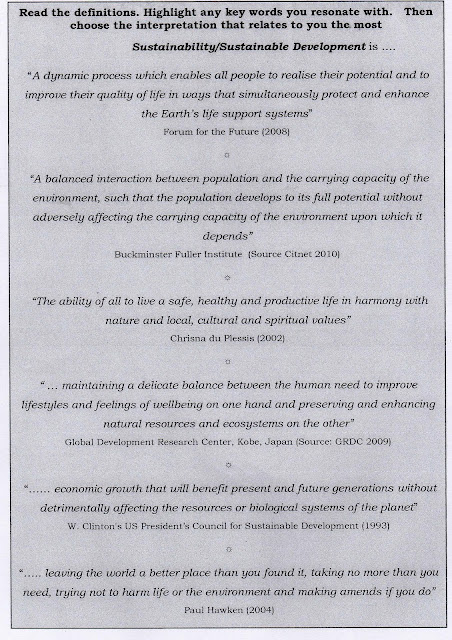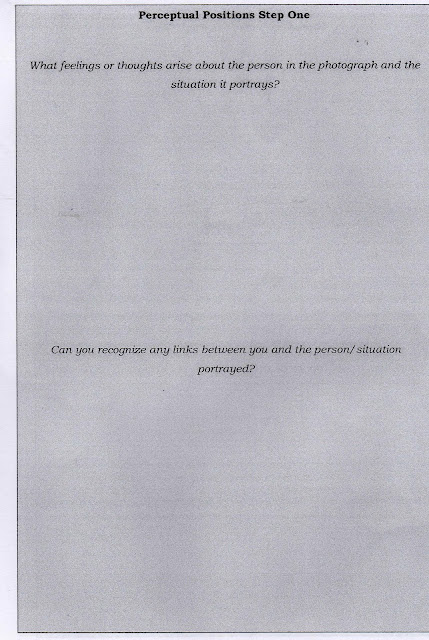ARIES 2009 Education for Sustainability: The Role of Education in Engaging and Equipping People for Change Commonwealth of Australia.
Australian Government Department of the Environment and Heritage 2007 Caring for Our Future: The Australian Government Strategy for the United Nations Decade of Education for Sustainable Development, 2005-2014 Commonwealth of Australia, ACT.
Bennet C I 2006 Strengthening Multicultural Perspective in Curriculum and Instruction in Comprehensive Multicultural Education: Theory and Practice eds C I Bennet, Pearson, Boston pp319-461.
Brundtland G 1987 Our Common Future: Chairman’s Foreword Our Common Future: Report of the World Commission on Environment and Development http://www.un-documents.net/ocf-cf.htm 25 Sept 2011.
Carson L, Cole-Edelstein L and Hardy M 2000 Citizen Juries in Australia- A Discussion about Protocols www.activedemocracy.net/articles/protocol.pdf 21 Sep 2011
Clugston R 2010 Earth Charter Education for Sustainable Ways of Living Journal of Education for Sustainable Development 4(2):157-166.
de Bono E 1995 Exploring Patterns of Thought…Serious Creativity The Journal for Quality and Participation 18(5): 12-18.
DeChano L M 2006 A Multi-Country Examination of the Relationship Between Environmental Knowledge and Attitudes International Research in Geographical and Environmental Education 15(1): 15-28
Department of Sustainability and Environment Victoria 2005 Effective Engagement: Building relationships with community and other stakeholders- Book One: Introduction to Engagement The Community Engagement Network, East Melbourne.
Fein J 2003 Learning to Care: Education and Compassion Australian Journal of Environmental Education 19: 1- 13
Ferreira J Ryan L and Tilbury D 2006 Whole-School approaches to sustainability: A review of models for professional development in pre-service teacher education. ARIES and Australian Government Department of the Environment and Heritage, ACT.
Friere P 2003 From Pedagogy of the Oppressed in A Darder M Baltodana and R D Torress eds The Critical Pedagogy Reader Routledge, New York pp 57-68
Herman H 1998 What is Open Space Technology? Open Space World. http://www.openspaceworld.org/cgi/wiki.cgi?AboutOpenSpace 21 Sep 2011
Hopkins C and McKeown R 2002 Education for Sustainable Development in D Tilbury R B Stevenson J Fein and D Schreuder Education and Sustainability, Responding to the Global Challenge, Commission on Education and Communication, IUCN.
Jackson M G 2011 The Real Challenge of ESD Journal of Sustainable Development 5(1): 27-31
Jickling B 1994 Why I Don’t Want My Children To Be Educated For Sustainable Development: Sustainable Belief Trumpeter 11(3):2-8.
Jucker R 2011 ESD between Systemic Change and Bureaucratic Obfuscation: Some Reflections on Environmental Education and Education for Sustainable Development in Switzerland Journal of Education for Sustainable Development 5(1):39-60
Monroe M C, Oxarart A, Mcdonell L and Plate R 2009 Using Community Forums to Enhance Public Engagement in Environmental Issues Journal of Education for Sustainable Development 3(2): 171-182.
Mula I and Tilbury D 2009 A United Nations Decade of Education for Sustainable Development (2005-14): What Difference will it Make? Journal of Education for Sustainable Development 3(1):87-97.
Murray P 2011 The Sustainable Self : A Personal Approach to Sustainability Education (Publisher Unknown)
NSW DET 2003 Quality Teaching in NSW Public Schools Department of Education and Training Professional Support and Curriculum Directorate, Sydney.
Preston N 2010 The Why and What of ESD: A Rationale for Earth Charter Education (and Naming Some of it Difficulties) Journal of Education for Sustainable Development 4(2):187-192
Robinson K 2010 Changing Education Paradigms TED Talk http://www.ted.com/talks/ken_robinson_changing_education_paradigms.html 5 Aug 2011
The Co-Intelligence Institute 2008 The World Café http://www.co-intelligence.org/P-worldcafe.html 21 Sep 2011
The Earth Charter Initiative: Values and Principles for a Sustainable Future n.d http://www.earthcharterinaction.org/content/pages/Read-the-Charter.html 21 Sep 2011.
Tilbury D and Fein J 2002 The Global Challenge of Sustainability in D Tilbury R B Stevenson J Fein and D Schreuder Education and Sustainability, Responding to the Global Challenge, Commission on Education and Communication, IUCN.
Tilbury D and Wortman D 2004 Engaging People in Sustainability, Commission on Education and Communication IUCN Gland, Switzerland and Cambridge UK.
UN 2002 Agenda 21, Section IV, Chapter 36, Promoting Education Public Awareness and Training UN Department of Economic and Social Affairs, Division for Sustainable Development http://www.un.org/esa/dsd/agenda21/res_agenda21_36.shtml 21 Sep 2011.


















